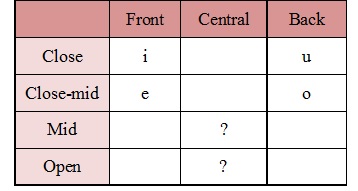Making It up as I Go: Inventing a Language
The interest in constructed languages (conlangs) has exploded in recent years, due in large part, I think, to shows like Game of Thrones that feature several intricately detailed conlangs. But for a long time, hardcore geeks and nerds were practically the only people who’d ever even considered creating their own made up languages. Sure, Klingon and Elvish were long-established examples of relatively popular conlangs, but who knew or cared about those? Hardcore geeks and nerds.

In my last semester as an undergrad, I took a linguistics course called Invented Languages, and it was easily the best, most challenging course I’ve ever taken throughout my 19 total years of formal education.
I minored in Linguistics, and I might have even changed my major had Linguistics been offered as a major at my university. I knocked the minor out pretty quickly because practically every course on offer grabbed my interest, so when I took Invented Languages, I didn’t really need it to graduate—and I think those classes that we don’t “need” and take just because we want to often end up being some of the most valuable and enjoyable.
Dr. Jessie Sams built the course, and you can read some of what she has to say about it in interviews published here and here.
The class I took was Jessie’s second time teaching it, and during that semester, she paired each student with a client who defined his or her basic needs regarding the language the student would construct. Some of the clients were building games, others were writing screenplays, and some were publishing novels or short stories, but the clients all had something in mind about what they wanted their language to look/sound like or be able to accomplish. Most of the clients had little to no existing knowledge of linguistics, so part of our responsibility in the class was to explain our choices and progress in such a way that virtually anyone could understand.
.gif)
My client, Mary, was working on a short story about married translators, Ellen and David, who have begun disconnecting with one another. In our initial conversation, Mary explained that her characters, in the midst of their marriage troubles, decide to abandon their failing attempts at traditional discourse and instead create their own languages in an effort to engage in more emotional dialog. They hope that by removing their ability to understand each other’s actual words, they will have a better chance of connecting with the emotional significance of what’s being said.
Mary tasked me with inventing Ellen’s language and told me that Ellen speaks multiple European languages and has some background in basic linguistics. Ellen struggles to express her emotions in general and so invents her language around the desire to articulate ideas she would typically leave unsaid. The only real restrictions Mary gave me were to construct a language unlike any language with which the character is likely to be familiar and to avoid any obvious language influence that an educated, adult, English-speaking audience might recognize.
.gif)
In the story, Ellen doesn’t name her language because she’s its only speaker, but I decided to name it Lelana (a transliteration of the character’s name that follows the linguistic constraints of the language) in order to talk and write about it with greater ease.
My first step was to determine what sounds would be present in Lelana—the phonemic inventory of the language. I reasoned that, because Ellen is familiar with many languages, she would likely produce a language that shares some typical features with natural world languages. Thus, I gave Lelana 19 consonants and six vowels, which falls into the average range of world languages. However, I still needed to make Lelana unlike other languages, especially European languages, so I took out the p, b, t, d, k, and g sounds (bilabials and stops). According to The World Atlas of Language Structures Online (WALS), less than 1% of known world languages have no bilabials, and no known world language has no stops.
The tables below show the phonemic inventory of consonants and vowels in Lelana. This interactive International Phonetic Alphabet chart can help you hear the sounds represented in the tables here. (All of us Linguistics students had an unreasonably good time repeating the recorded voice from the interactive chart; I still do it sometimes just for fun.)
Table 1: Phonemic consonants of Lelana

ʍ Voiceless labial-velar fricative
w Voiced labial-velar approximant
Table 2: Phonemic vowels of Lelana

Lelana possesses many more fricatives than the average among world languages; the course text Jessie wrote explains that 57.8% of world languages have 1-4 fricatives, but Lelana has twelve. With the exception of the voiced and voiceless retroflex fricatives, [ʂ] and [ʐ], all of Lelana’s sounds are present in English. These retroflex consonants are, however, familiar to Ellen (and likely to some readers as well) because of their occurrence in languages with which she has probably had at least some contact in her work as a translator, such as Mandarin Chinese and Russian. The voiced glottal fricative [ɦ] may also be unfamiliar to some speakers, but, again, Ellen will have had exposure to it through such languages as Hebrew and Dutch.
Lelana’s vowel inventory is comprised of the five pure vowels and the mid-central vowel [ə]. The language uses no diphthongs—such as [aɪ] (as in fly), [eɪ] (as in day), [ɔɪ] (as in toy), or [aʊ] (as in how)—which are incredibly common in English.
After working out what sounds Lelana would use, I had to figure out what the syllable rules were for the language, how words and sentences would be formed, what special rules existed, how the grammar of the language would function, what it would look like in writing, and many other things that we know about our own language without really knowing that we know them, you know?
In my next post on Lelana, I’ll share some of those elements with you and provide some examples and explanations about my conlanging adventure.
I welcome your comments and questions, and if you’re digging what’s here so far, I invite you to follow for more like this in the near future!
This is so much fun! But I want to know how we've gone this long without you sharing that Interactive IPA Chart before this. That is seriously my new favorite thing. I want it on a little handheld so anyone who annoys me, I can just respond with sounds of disgust from the "Close Central" vowels lol.
Congratulations @nayzer! You have completed some achievement on Steemit and have been rewarded with new badge(s) :
Click on any badge to view your own Board of Honnor on SteemitBoard.
For more information about SteemitBoard, click here
If you no longer want to receive notifications, reply to this comment with the word
STOPIf you want to support the SteemitBoard project, your upvote for this notification is welcome!
Conlangs are such great fun! I did Esperanto, but now the ones I study are Hebrew and Nynorsk.
Congratulations @nayzer! You received a personal award!
You can view your badges on your Steem Board and compare to others on the Steem Ranking
Vote for @Steemitboard as a witness to get one more award and increased upvotes!